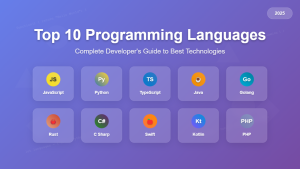JavaScript, the language that powers the web, is constantly evolving. With each new ECMAScript specification, developers gain access to powerful new features that enhance productivity and code quality. In this article, we'll dive deep into the exciting world of ES Next, exploring upcoming language features that are set to revolutionize the way we write JavaScript.
What is ES Next?
ES Next is a term used to describe the upcoming version of ECMAScript, the standardized specification for JavaScript. It encompasses features that are currently in the proposal stage and are likely to be included in future versions of the language.
🔍 Fun Fact: ECMAScript versions are now released annually, with new features being added incrementally rather than in large, infrequent updates.
The TC39 Process
Before we delve into the upcoming features, it's essential to understand the process by which new features are added to JavaScript. The TC39 (Technical Committee 39) is responsible for evolving the ECMAScript specification. They follow a stage-based process:
- Stage 0: Strawman
- Stage 1: Proposal
- Stage 2: Draft
- Stage 3: Candidate
- Stage 4: Finished
Features at Stage 3 or 4 are most likely to be included in the next ECMAScript release. Let's explore some of the most exciting proposals currently in the pipeline.
Record and Tuple
Records and Tuples introduce deeply immutable data structures to JavaScript. They are similar to objects and arrays but are immutable by default.
Records
Records are similar to objects but are immutable and compare by value rather than by reference.
const point = #{x: 10, y: 20};
const anotherPoint = #{x: 10, y: 20};
console.log(point === anotherPoint); // true
In this example, point and anotherPoint are records. Despite being created separately, they are considered equal because they have the same structure and values.
Tuples
Tuples are similar to arrays but are immutable and compare by value.
const rgb = #[255, 0, 128];
const anotherRgb = #[255, 0, 128];
console.log(rgb === anotherRgb); // true
Here, rgb and anotherRgb are tuples. They are considered equal because they contain the same values in the same order.
🚀 Pro Tip: Records and Tuples are perfect for representing fixed data structures, like coordinates or color values, where you want to ensure data integrity and easy comparison.
Pattern Matching
Pattern matching is a powerful feature that allows for more expressive and less error-prone code when working with complex data structures. It's particularly useful when dealing with nested objects or arrays.
const response = {
status: 'success',
data: {
user: {
name: 'John Doe',
age: 30
}
}
};
const result = match (response) {
{ status: 'success', data: { user: { name, age } } } => `${name} is ${age} years old`,
{ status: 'error', message } => `Error: ${message}`,
_ => 'Unknown response'
};
console.log(result); // "John Doe is 30 years old"
In this example, we use pattern matching to extract the name and age from a nested object structure. If the structure doesn't match, it falls back to other patterns or a default case.
Pipeline Operator
The pipeline operator (|>) aims to simplify the chaining of function calls, making code more readable and maintainable.
const double = x => x * 2;
const addFive = x => x + 5;
const square = x => x * x;
// Without pipeline operator
const result = square(addFive(double(5)));
console.log(result); // 225
// With pipeline operator
const pipelineResult = 5 |> double |> addFive |> square;
console.log(pipelineResult); // 225
The pipeline operator allows us to read the operations from left to right, making it easier to understand the sequence of transformations applied to the initial value.
💡 Insight: The pipeline operator is particularly useful when working with data transformation pipelines, such as in functional programming paradigms or data processing workflows.
Decorators
Decorators provide a clean way to modify or enhance the behavior of classes and their members. While decorators have been available in TypeScript for a while, they're now making their way into JavaScript.
function logged(target, name, descriptor) {
const original = descriptor.value;
descriptor.value = function(...args) {
console.log(`Calling ${name} with arguments: ${args}`);
return original.apply(this, args);
};
return descriptor;
}
class Calculator {
@logged
add(a, b) {
return a + b;
}
}
const calc = new Calculator();
console.log(calc.add(2, 3));
// Output:
// Calling add with arguments: 2,3
// 5
In this example, we define a @logged decorator that logs method calls. When applied to the add method, it automatically logs the method name and arguments before executing the original method.
Optional Chaining
Optional chaining (?.) allows you to safely access nested object properties without worrying about null or undefined values.
const user = {
name: 'Alice',
address: {
street: '123 Main St',
city: 'Wonderland'
}
};
// Without optional chaining
const zipCode = user.address && user.address.zipCode ? user.address.zipCode : 'Unknown';
// With optional chaining
const zipCodeOptional = user.address?.zipCode ?? 'Unknown';
console.log(zipCode); // "Unknown"
console.log(zipCodeOptional); // "Unknown"
Optional chaining simplifies the process of accessing nested properties, especially when dealing with potentially undefined or null values in the object hierarchy.
Nullish Coalescing
The nullish coalescing operator (??) provides a concise way to handle default values for null or undefined, but not for other falsy values.
const config = {
timeout: 0,
retries: null
};
// Without nullish coalescing
const timeout = config.timeout !== undefined && config.timeout !== null ? config.timeout : 1000;
const retries = config.retries !== undefined && config.retries !== null ? config.retries : 3;
// With nullish coalescing
const timeoutNC = config.timeout ?? 1000;
const retriesNC = config.retries ?? 3;
console.log(timeout); // 0
console.log(timeoutNC); // 0
console.log(retries); // 3
console.log(retriesNC); // 3
The nullish coalescing operator is particularly useful when you want to distinguish between null/undefined and other falsy values like 0 or an empty string.
Top-level Await
Top-level await allows the use of the await keyword outside of async functions, making it easier to write asynchronous code at the module level.
// config.js
export const config = await fetch('/api/config').then(res => res.json());
// main.js
import { config } from './config.js';
console.log(config); // The imported config is already resolved
This feature is particularly useful for module initialization that requires asynchronous operations, such as loading configuration from a remote server or initializing a database connection.
Private Fields and Methods
Private fields and methods provide a way to encapsulate class internals, preventing access from outside the class.
class BankAccount {
#balance = 0;
constructor(initialBalance) {
this.#balance = initialBalance;
}
#validateTransaction(amount) {
return this.#balance >= amount;
}
withdraw(amount) {
if (this.#validateTransaction(amount)) {
this.#balance -= amount;
return true;
}
return false;
}
get balance() {
return this.#balance;
}
}
const account = new BankAccount(100);
console.log(account.balance); // 100
console.log(account.withdraw(50)); // true
console.log(account.balance); // 50
console.log(account.#balance); // SyntaxError: Private field '#balance' must be declared in an enclosing class
In this example, #balance is a private field, and #validateTransaction is a private method. They can only be accessed within the BankAccount class, providing better encapsulation and preventing unintended modifications from outside the class.
Static Class Fields and Methods
Static class fields and methods belong to the class itself rather than to instances of the class. They're useful for utility functions or shared state across all instances.
class MathOperations {
static PI = 3.14159;
static square(x) {
return x * x;
}
static cube(x) {
return x * x * x;
}
}
console.log(MathOperations.PI); // 3.14159
console.log(MathOperations.square(4)); // 16
console.log(MathOperations.cube(3)); // 27
Static members can be accessed directly on the class without needing to create an instance, making them ideal for utility classes or factory methods.
Numeric Separators
Numeric separators allow you to use underscores as visual separators in numeric literals, making large numbers more readable.
const billion = 1_000_000_000;
const bytes = 0b1111_1111;
const hex = 0xFF_FF_FF_FF;
console.log(billion); // 1000000000
console.log(bytes); // 255
console.log(hex); // 4294967295
This feature doesn't change the value of the number; it's purely for improving readability in code.
BigInt
BigInt is a new primitive type for working with arbitrarily large integers.
const maxSafeInteger = Number.MAX_SAFE_INTEGER;
console.log(maxSafeInteger); // 9007199254740991
const bigInt = 9007199254740991n;
console.log(bigInt + 1n); // 9007199254740992n
const result = bigInt * 2n;
console.log(result); // 18014398509481982n
console.log(typeof bigInt); // "bigint"
BigInt allows for precise integer calculations beyond the safe integer limit of JavaScript's Number type, which is crucial for financial calculations or working with very large numbers.
Conclusion
The future of JavaScript looks bright with these upcoming features. From improved syntax for common patterns to new data types and powerful abstractions, ES Next promises to make JavaScript development more efficient and expressive.
As these features progress through the TC39 process, it's important to keep an eye on their status and browser support. While some features may be available through transpilers or polyfills, others may require patience until they're fully implemented in browsers and Node.js.
By staying informed about these upcoming features, you'll be well-prepared to leverage them in your projects as soon as they become available, writing cleaner, more efficient, and more powerful JavaScript code.
🌟 Remember: The JavaScript ecosystem is constantly evolving. Keep learning, experimenting, and pushing the boundaries of what's possible with this versatile language!



















